☆ PuniPuni Youtube ☆
Japanese Grammar Lesson 8: ます-verbs – Review Notes
Today we learned about polite non-past verbs in Japanese! This verb form is commonly referred to as the ます (masu) form because verbs in this form always end in ます! In this review we will go over the concepts from the video and see some more examples.
………………………………………………………………………………..
What is a polite non-past verb?
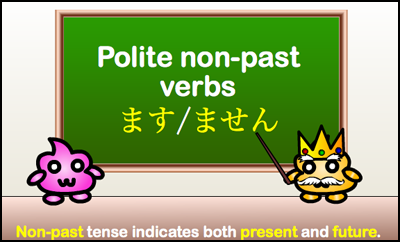
★ In Japanese there is a polite form of verbs and a casual form of verbs.
★ Today we learned the polite form of verbs, also known as the ます (masu) form of verbs.
★ Japanese has 2 verb tenses: past and non-past. Non-past indicates both present and future. This means that the same sentence often has two possible translations. You can understand if it is being used for the present or future by the context of the sentence.
★ We learned both the affirmative and the negative forms of these verbs.
………………………………………………………………………………..
Some examples of polite non-past verbs:
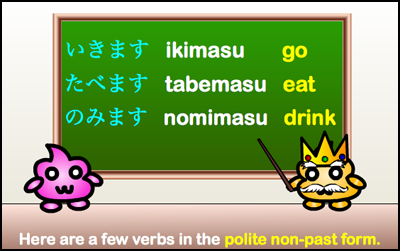
★ We learned three verbs in the polite non-past form.
★ Verbs in this form always end in ます (masu).
★ If you want to know the kanji, here they are from top to bottom: 行きます、食べます、飲みます
………………………………………………………………………………..
Affirmative Form: ます (masu)

★ がっこうにいきます can mean either “I go to school” (present) or “I will go to school” (future) depending on the context of the sentence.
………………………………………………………………………………..

★ おかしをたべます can mean either “I eat snacks” (present) or “I will eat snacks” (future) depending on the context of the sentence.
………………………………………………………………………………..

★ ジュースをのみます can mean either “I drink juice” (present) or “I will drink juice” (future) depending on the context of the sentence.
………………………………………………………………………………..
Negative form: ません (masen)
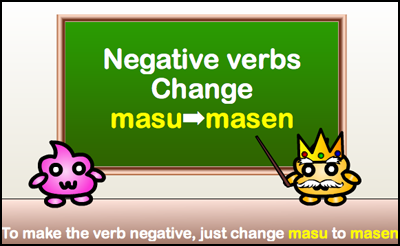
★ To make the verb negative, we can change the ending ます (masu) to ません (masen).
★ For example:
いきます ➡ いきません
ikimasu ➡ ikimasen
go/will go ➡ don’t go/won’t go
………………………………………………………………………………..

★ To make this sentence negative we changed the ending of the verb from ます (masu) to ません (masen).
………………………………………………………………………………..
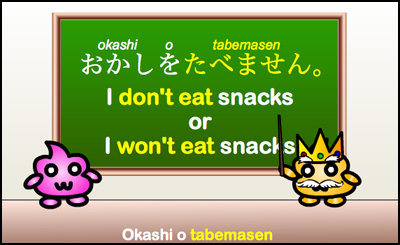
★ To make this sentence negative we changed the ending of the verb from ます (masu) to ません (masen).
………………………………………………………………………………..

★ To make this sentence negative we changed the ending of the verb from ます (masu) to ません (masen).
………………………………………………………………………………..
Example 1:
日本語を勉強します。
Nihongo o benkyō shimasu.
I study Japanese/I will study Japanese
………………………………………………………………………………..
Example 2:
今日は友達と遊びます。
Kyō wa tomodachi to asobimasu.
Today I will hang out withmy friend.
………………………………………………………………………………..
Example 3:
私はテレビをあまり見ません。
Watashi wa terebi o amari mimasen.
I don’t watch television very much.
………………………………………………………………………………..
Additional verbs list:
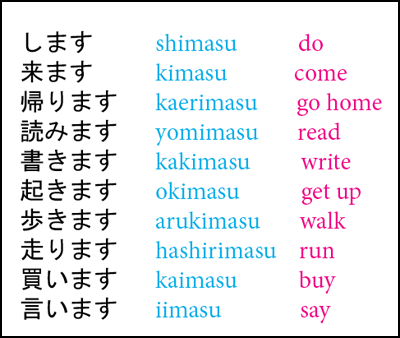
………………………………………………………………………………..
Conclusion:
Today we learned about the polite non-past form, AKA the ます (masu) form of verbs. We learned that these verbs always end in ます, unless they are negative in which case they end in ません (masen). The non-past form indicates both the present and the future.
………………………………………………………………………………..
Get Japanese dictionary!
Do you want to know a lot of Japanese words? I recommend you to get a dictionary!
If you have dictionary, you can always look up new Japanese words\(◕ω◕)/♥
………………………………………………………………………………..
Do you want a Japanese tutor?
Take Japanese Skype Lessons with Professional Japanese Teachers on kakehashijapan.com!
………………………………………………………………………………..
………………………………………………………………………………..












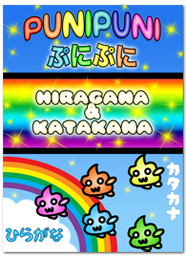
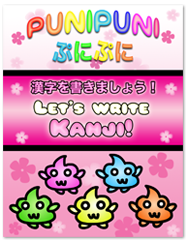


19 comments
When do you need to use watashi? For example “Watashi wa terebi o amari mimasen” versus “Nihongo o benkyō shimasu.” and does it work the same for he/she?
Comment by ARS on 10/15/2012 at 5:54 amThe use of watashi (I) or kare/kanojo (he/she) are usually considered optional. In most cases, it is correct whether you use it or not. For example, “Watashi wa nihongo o benkyō shimasu” is ok, but it is often shortened to “nihongo o benkyō shimasu” when it is obvious from the context that you are talking about yourself. Similarly, if you are talking about someone else and he has already been mentioned as the topic previously, then you do not need to put “kare.” Basically, if you can tell from the context who is the topic of the sentence, you can put it but you don’t have to. If it is not obvious from the context (like if you are changing the topic), then it is better to put it. Does that make sense(◕ω◕)?
Comment by PuniPuni on 10/15/2012 at 11:39 amAh thank you so much for the speedy and detailed response, that makes perfect sense!! btw unrelated but i love the food recommendation emails Tamagoyaki is really easy to make and good!
Comment by ARS on 10/15/2012 at 4:44 pmWe are happy to hear that! We love Japanese food so we want to share it with everyone! \(>ω<)/♥
Comment by PuniPuni on 10/17/2012 at 9:19 amI have a question.Is there a difference between the present tense and present continous tense?
Comment by Amir on 11/28/2012 at 7:23 amYes! There is a difference. We have not yet written about the Japanese present progressive (present continuous), but it is fairly simple if you know how to make the -te form of the verb.
For example, 食べる (taberu [plain form]) / 食べます (tabemasu [polite form]) is the present tense verb “eat”. It’s -te form is 食べて (tabete). To make the present progressive form, you just add -iru (or -imasu for polite speech) to the end of the -te form. So, the present progressive of 食べる (taberu) is 食べている (tabeteiru [plain form]) or 食べています (tabeteimasu [polite form]) which means “eating”.
So, the main thing you have to know is actually how to make the -te form of the verb. We will be making a lesson on this someday, but it is a little more advanced! If you still have questions, please feel free to ask (◕ω◕)♥
Comment by PuniPuni on 11/28/2012 at 6:01 pmI don’t get it, if to change a verb to present progressive you add -te, why are some verbs not like this? Maybe this is just a bad translation of a song, but “sway” is yurari, and “swaying” is yureru? Shouldn’t it have a -te ending? Same for other words, like utau, and hashiru. >.<
Comment by MewQueen on 01/27/2013 at 9:11 pmThe present progressive is formed by using the -te form of the verb plus “iru” (or “imasu”). You’re right, it’s probably not a literal translation (that is not to say that it is necessarily a bad translation – sometimes the literal translation doesn’t sound as good).
Yurari is an adverb that means “swaying” (only once, in a large, slow motion). Yureru is the plain form of the verb meaning “to sway”, so literally it would translate as “sway” or “sways” (◕ω◕)♪ If you want to form the present progressive verb “swaying” a literal translation would be “yureteiru” (-te form + iru).
It is the same with other verbs as well☆ “Utau” (sing/sings) would become “utatteiru” (singing) and “hashiru” (run/runs) would become “hashitteiru” (running).
I hope that helps (◕ω<)♥ We will try to make a video about the -te form of verbs soon, and about the present progressive!
Comment by PuniPuni on 01/28/2013 at 8:35 pmHow do you use sentences with two verbs in it in japanese. For example: “I eat fish” would be 魚をたべますin japanese, and “I like fish” would be さかながすきです. (correct me if I’m wrong). But how do I combine them so i can say the sentence “I like eating fish” in japanese ?
I hope the question is understandable english is not my native language
Comment by Ahoy Hoy on 02/08/2013 at 7:37 am好き (suki – like) is actually not a verb in Japanese (although it is in English), but I know what you are asking. “I like eating fish” in Japanese is 魚を食べることが好きです。(sakana o taberu koto ga suki desu). When you want to say you like doing something in Japanese, you use the verb + こと (koto). Other examples are: 本を読むことが好きです。(hon o yomu koto ga suki desu – I like reading books) and アニメを見ることが好きです。(anime o miru koto ga suki desu – I like watching anime). Hope that helps \(◕ω◕)/☆
Comment by PuniPuni on 02/08/2013 at 7:43 pmThank you very much. I think I understand it now.
Comment by Ahoy Hoy on 02/09/2013 at 6:44 amHow can you say in japanese that you see/saw someone doing something.”
For Example how would the sentence:”I saw the children playing in the garden” translate into japanese ?
Comment by TheEyeofSauron on 04/17/2013 at 4:58 pmI saw the children playing in the garden in Japanese is: 子供が庭で遊んでいるのを見ました。(kodomo ga niwa de asondeiru no o mimashita). The way that you make this sentence is: 1. Say “kids are playing in the garden” (kodomo ga niwa de asondeiru) 2. Add the particle “no” 3. Add the particle “o” + mimashita (saw) (◕ω◕)☆
Comment by PuniPuni on 04/18/2013 at 8:27 amHow would you say “I want/don’t want to (do something)” and “I can/can’t (do something)”?
Comment by Tash on 03/01/2014 at 8:48 pmEg: I want to eat, I can’t speak Japanese.
See this lesson to learn how to express “want to (do something)”: http://www.punipunijapan.com/tai-form/
We haven’t made a lesson about how to express ability yet, but one way is to use the sentence pattern “~(verb) koto ga dekimasu (can)/dekimasen(can’t)”
For example: I can’t speak Japanese – 私は日本語を話すことができません。(watashi wa nihongo o hanasu koto ga dekimasen)
We will make a lesson on the different ways to say “can” and “can’t” in the near future! Until then, if you have any more specific questions, feel free to ask! (◕ω<)b☆
Comment by PuniPuni on 03/07/2014 at 2:51 amThis is a little unrelated, but I wanted to know really bad. You showed us “Gakko ni Ikimasen” earlier, and in the writing of it, after the ga part, there was a little symbol that sort of looked like Tsu. However, it obviously isn’t. Could you tell me what that is?
Comment by Amber on 04/03/2014 at 9:45 amNo problem! (◕ω<)b☆ If you get our free Japanese ebooks, you can read about this! In hiragana/katakana, the small "tsu" symbol is used to double a consonant sound. For example the "k" in "gakkō." You can get our free hiragana/katakana ebooks here: http://www.punipunijapan.com/free-stuff/
Comment by PuniPuni on 04/03/2014 at 9:49 amis this correct
watashi ga asu wa kyuji ni okimasu
tomorrow i will wake up at 9
Comment by Noman on 07/25/2014 at 3:35 amYou can say “ashita kuji ni okimasu.” You do not need to say “watashi” (I) every time in Japanese like you do in English.
Comment by PuniPuni on 08/01/2014 at 8:08 am